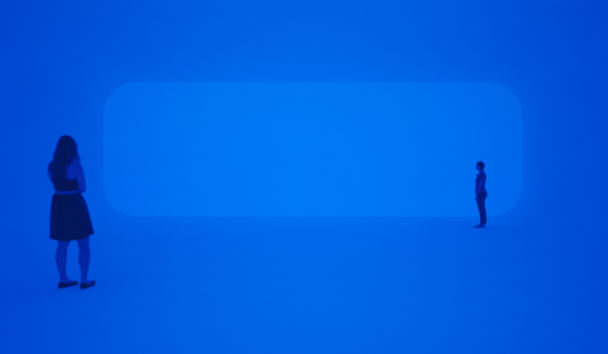 The most exciting exhibit of the year opens at LACMA on Sunday, just in time for summer exploration. James Turrell: A Retrospective revels in the pure sensation and joy of Turrell’s work over the past 50 years. The 70 year-old artist works with light and sky, playing with the biology of vision and coaxing our eyes and brains into seeing something that we didn’t know existed. Most of the second floor of BCAM is taken up with large rooms that hold a single Turrell piece – perhaps a blue, neon triangle hovering from one side of a clean gallery, or a white cube nestled into the corner — this is Afrum (White). By staring at these images for several moments, one’s perception shifts. Is the neon triangle really a pyramid? Does the cube recede into the corner or pop out again towards the viewer? It’s gratifying to walk around the space, changing one’s perception on the work and sensing our brain adjusting to the shifting ‘reality’.
The most exciting exhibit of the year opens at LACMA on Sunday, just in time for summer exploration. James Turrell: A Retrospective revels in the pure sensation and joy of Turrell’s work over the past 50 years. The 70 year-old artist works with light and sky, playing with the biology of vision and coaxing our eyes and brains into seeing something that we didn’t know existed. Most of the second floor of BCAM is taken up with large rooms that hold a single Turrell piece – perhaps a blue, neon triangle hovering from one side of a clean gallery, or a white cube nestled into the corner — this is Afrum (White). By staring at these images for several moments, one’s perception shifts. Is the neon triangle really a pyramid? Does the cube recede into the corner or pop out again towards the viewer? It’s gratifying to walk around the space, changing one’s perception on the work and sensing our brain adjusting to the shifting ‘reality’.
In other rooms, visitors enter in pitch blackness and stand patiently until a glow of light gradually appears. It’s a strangely comforting experience, as if the light is finally embracing you. It’s friendly and easy to adore, this work. And it’s only light, which is what art has been about from the beginning.. The sense of comfort lends itself to spiritual feelings of connection – after all, your eye is not being tricked so much as you are seeing something that has been there all along, but has simply not been perceptible. Coming out of the room afterwards, you can’t believe that you couldn’t see the walls upon entrance only a few moments earlier. In some rooms, one encounters neon walls, bright colors that project a beckoning hum. The biggest space to enter is pictured above and is titled ganzfeld. Visitors don booties and are admitted in small groups to a large glowing space. Sometimes pink, sometimes blue and (probably many other colors as well).
Turrell talks about the difference between light in different cities – he recently put a Skyspace in Beijing and says you can “eat that air with a fork,” because of the layers of pollution. But it produces a beautiful, and different result, than the dry skies of Arizona or these soft California hues. Many of his Skyspaces are made for private individuals, but there are several of his public works in Southern California – and you can bet they’re on our summer itinerary.
Interestingly, some of the most spectacular of his works are not able to be displayed in a museum (the Skyspaces) but by starting with the LACMA show and learning about the thinking process of an artist who pioneered the California Light and Space movement in the 1960s and 1970s, families will be able to visit one of five local Skyspaces and have a better idea of what to expect (and how work produces such cool affects).
Here is a recent article about the artist in the New York Times Travel Magazine that explains the phenomenon in the art, and here are a few local Turrell viewing opportunities — the KayneGriffinCorcoran Gallery (nearby on 1201 La Brea) has a show that outlines Turrell’s plans for his much-anticipated (but not yet financed) Roden Crater project. You will be able to view a Skyspace at this show (opening 5/15). And Pomona College has a Turrell called Dividing the Light that is viewable at sunrise or sunset from Saturday – Monday.
Advanced tickets are required, because this work requires more time from the visitors than a typical museum show; for many of the exhibits, a full 10 minutes of sitting in the dark is requested. And, Perpetual Cell, which is sold out until August, requires a 12 minute immersion by the guest. This is for kids over 17, only.

